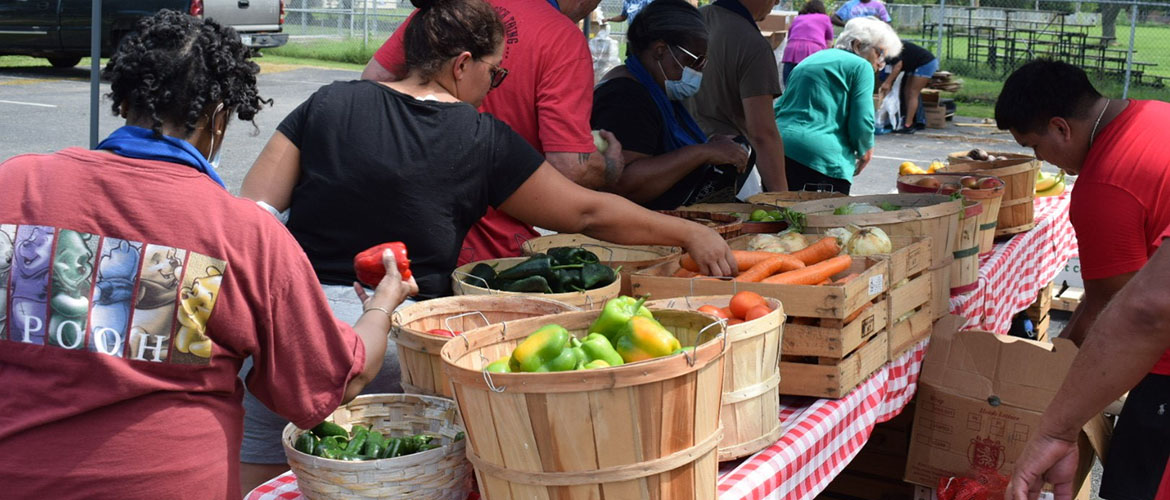Food insecurity persists even as the economy rebounds from the downturn caused by the COVID-19 pandemic. More than 1 million Illinois residents will have difficulty accessing food for themselves and their families this year.
Sarah Bermingham, a partner resource coordinator at the Springfield-based Central Illinois Foodbank, has heard some of their distressing stories. “An older woman said the food she was picking up would stretch her budget so she could buy medicine,” Bermingham recalls. “That’s one of the most heartbreaking ones.”
Since the start of the pandemic, the food bank has increased the amount of food distributed by 20%, serving about 100,000 people and 40,000 families. A quarter of those served have been new clients.
Blue Cross and Blue Shield of Illinois (BCBSIL) has a longstanding commitment to investing in food banks across Illinois and supporting sustainable resources and strategies to combat hunger and improve health.
“Our partnership has provided fresh produce, protein, and dairy to people facing food insecurity — many for the first time — during a time of unprecedented need.”
Those local food banks, with help from the national hunger-relief organization Feeding America, are buying nutritious and culturally appropriate foods for the communities they serve. They’re also developing and implementing policies focused on finding a larger variety of nutritious foods needed to help prevent diet-related conditions that can compromise their clients’ health.
“We know that job loss and other financial impacts from the pandemic put pressure on local food banks to increase food access in their communities,” says BCBSIL President Steve Hamman. “We are proud to support these organizations as they work to help put healthy food in homes and address the potential long-term health impacts of hunger, including mental health challenges, delayed child development and increased risk of chronic disease.”
In 2020, almost 11% of American households had trouble feeding all family members, according to a U.S. Department of Agriculture report. Meantime, an existing gap between Black and white households expanded, with nearly 22% of Black households experiencing food insecurity, compared with a little more than 7% of white households.
A focus on nutrition and culture
That struggle to feed themselves and their families puts people at risk for a lifetime of poor health outcomes and disparities. Research shows food insecurity can lead to hypertension, stroke, cancer, diabetes, chronic obstructive pulmonary disease and kidney disease.
“When someone has food insecurity, they're oftentimes dealing with trade-offs with food and other basic needs or engaging in coping strategies such as eating fewer meals or watering down their meals,” says Jessica Hager, Feeding America’s director of health care partnerships and nutrition.
This year BCBSIL has invested in Feeding America’s work focusing on closing nutritional gaps, addressing health disparities and creating culturally competent connections with food bank clients. Central Illinois Foodbank is among 26 food banks carrying out this work with Feeding America grants supported by Blue Cross and Blue Shield plans in Illinois, Montana, New Mexico, Oklahoma and Texas.
The organizations in Illinois are:
- Greater Chicago Food Depository
- Cenral Illinois Foodbank
- Eastern Illinois Foodbank
- Northern Illinois Food Bank
The projects include surveying and engaging their communities to understand their food needs and cultural preferences, while building trust with the people they serve and working to provide communities with a better balance of nutritious foods.
“This goes beyond food categories of protein, dairy and produce, but really what are the specific ingredients that are traditional or special in one's culture,” Hager says. “We know that in the United States there's such great diversity in our food and the cultures that are represented, and we as a food bank network want to be able to meet those food needs and preferences.”
Central Illinois Foodbank, which works with more than 150 community partners to feed residents in 21 counties, is assessing the need for more culturally appropriate foods and targeting a few areas, including Beardstown, which has a significant Latino population. It also has provided fresh produce, protein and dairy products to pregnant women and families with children younger than age 5 and is reaching out to Illinois farms to directly buy fruits, vegetables, cheese, meat and dairy products.
“We are so grateful to Blue Cross and Blue Shield of Illinois for its dedication to ensure our neighbors have access to healthy, nutritious foods,” says Pam Malitoris, Central Illinois Foodbank’s executive director. “Our partnership has provided fresh produce, protein, and dairy to people facing food insecurity, many for the first time, during a time of unprecedented need.”

